Clay lakes usually have clean water. Some are used for formal swimming and other water activities, but most ban swimming. This is a plea for, and information on, making these beautiful places free for people to swim and enjoy responsibly and safely, with some advice on local conditions. This would bring a wide range of benefits. On my swim & explore trips over summer 2019 I had several lovely experiences of clay lake swims, formal and wild, and could not see why they were more dangerous than anywhere else, or why those risks could not be mitigated.
I was intrigued to read about the lake at the Forest of Marston Vale (a wonderful forest park), where managers posted a No Swimming message on social media earlier that summer: “It may look tempting, but swimming in old clay pits is dangerous. Variable depths and water temperatures along with old machinery and industrial debris pose significant risk…”
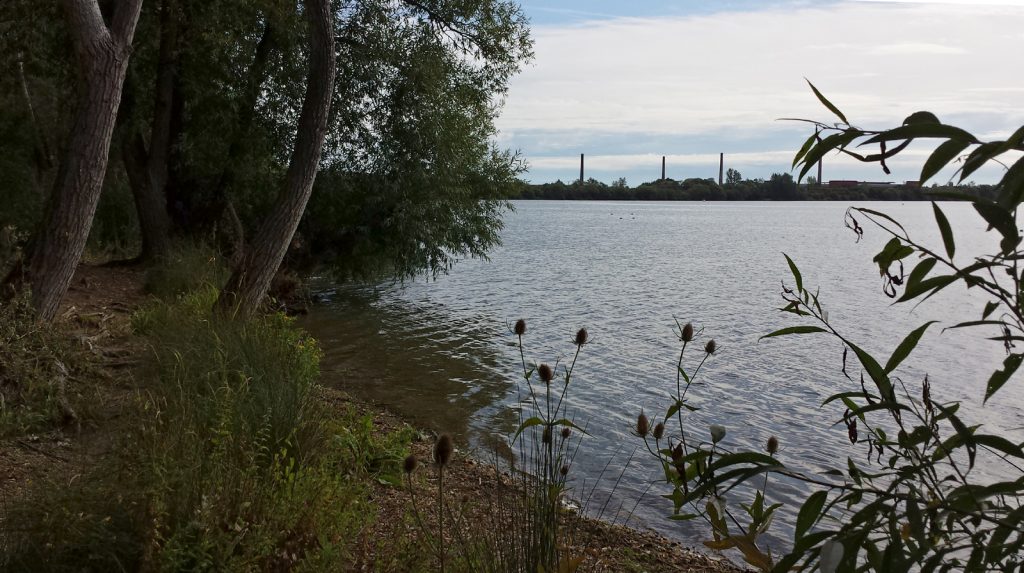
Clearly people were swimming there, so I was interested to see it and research it for myself. OS maps and the site map show public access on footpaths around the lake. I could see no reason not to, so I swam there during my August Beds area trip. The water was warm, clean, the beach shallow gravel, with delightful wooded glades, and birds happily swam and flew around me.
So is it dangerous? Do “Variable depths and water temperatures along with old machinery and industrial debris pose significant risk…”?
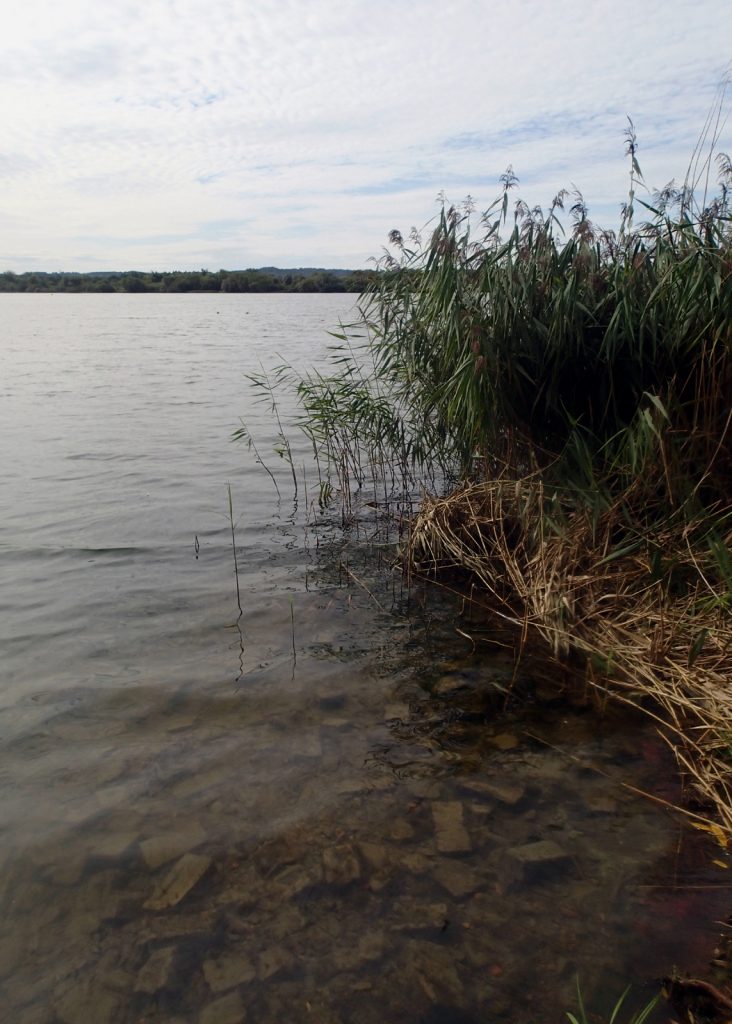
There is probably industrial debris sunk somewhere in the lake, but it seems unlikely it would affect anyone who swam from the beaches. On a return visit later in August I explored further around the lake, and found that about half of the many beaches have old bricks on the water’s edge. But these could be easily seen and avoided in the clear water, or avoided by picking a different beach, and wearing swim shoes is always good advice. The temperature and depth will vary in any waters, and it is sensible to always keep a close eye on children and non-swimmers near water. Standard advice is for any lake swimmer to stay within reach of the shore in case they get cold and need to get out, and to be especially wary if there is powerboating or sailing in part of a lake.
So I was left unsure why “swimming in old clay pits is dangerous” – any more than anywhere else, that is.
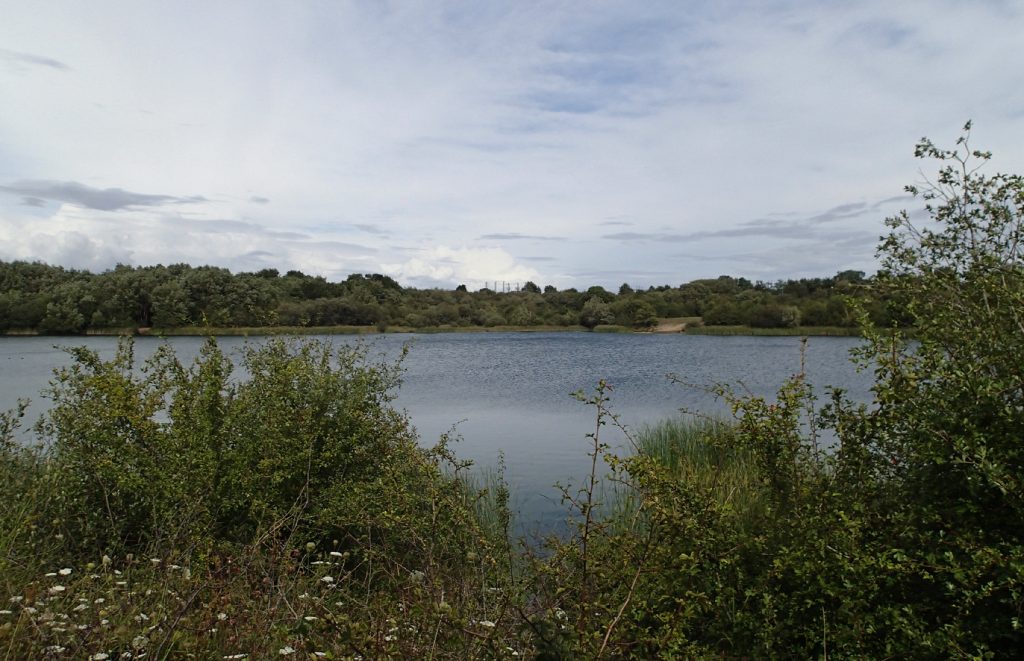
I had also heard scare stories about the Blue Lagoon in Bletchley, Milton Keynes, and some years ago had walked round and thought it looked lovely. So I made sure I included it on my trip. Again it was warm, silky, clear water, full of wildlife that were unconcerned that nearby people were picnicking, camping, having bbqs, swimming and fishing. A diving club uses it twice weekly. In 2020 it has become more popular with regular swimmers in all seasons.
I swam in the organised Box End venue, which was friendly and the rules are not too restrictive, and have a few times swum at Gildenburgh Water in the Fens – a small diving lake that welcomes swimmers too. Both are clear blue clay lakes.
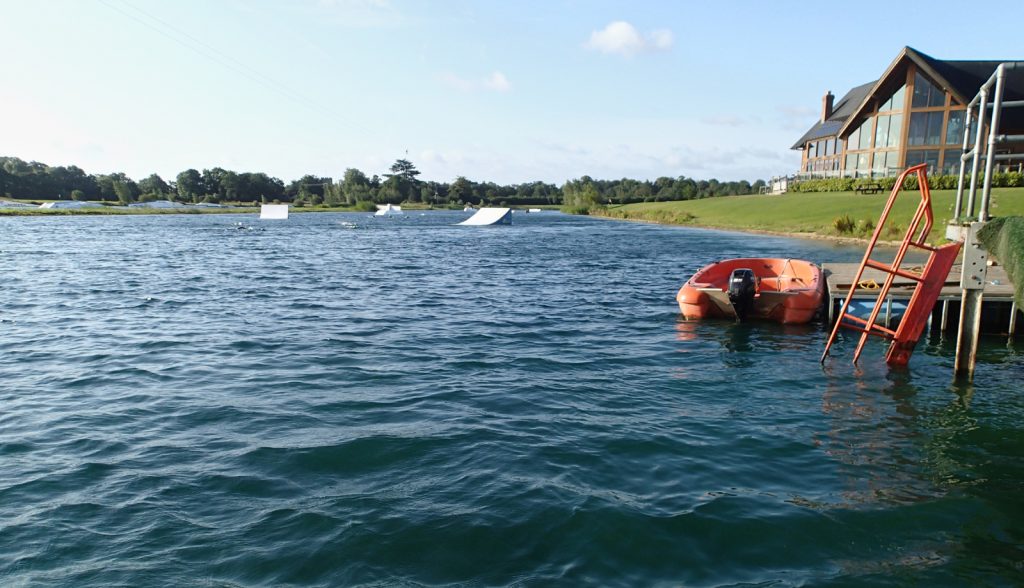
The water in all these lakes is clean, clear, warm, and the surroundings beautiful. Sometimes these were solitary and quiet, at other places full of people. Even on a hot summer day in a lake in an urban area there was space for people to spread out. Wildlife abounds, happily coexisting with people swimming.

Clay lakes are usually very clean, particularly nice for swimming, as clay is less likely to silt. Organised swimming and diving venues boast of the water clarity.
Organised venues are nice, full of friendly swimmers supportive of each other. Many swimmers like to have a marked course and some safety cover, especially if new to OWS. But this is not for everyone: many will want free casual and wild swimming, especially families and young people. You have to pay, sometimes rules are complex and restrictive, and they are only open at set times.
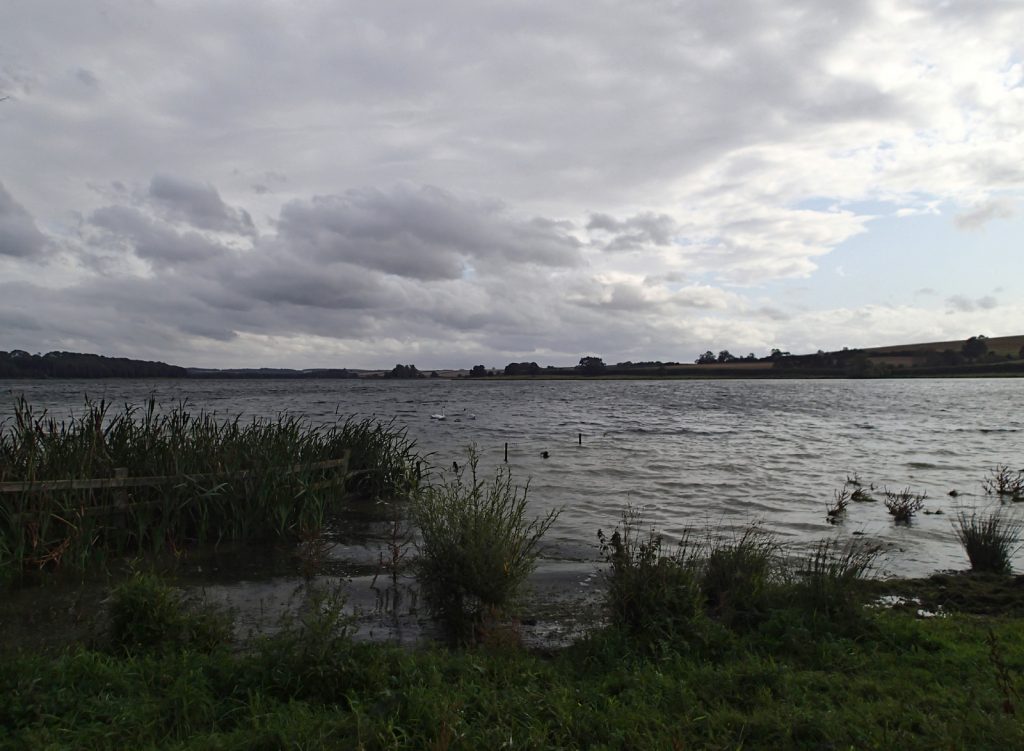
I had one swim at a reservoir, when it was very windy and wild, very warm and great fun. The water was unusually high, submerging the grass and meaning a gradual entry through weeds, until far enough out to swim in the slapping waves. I’d been there before on a hot sunny day, when many others were enjoying the shallow water.
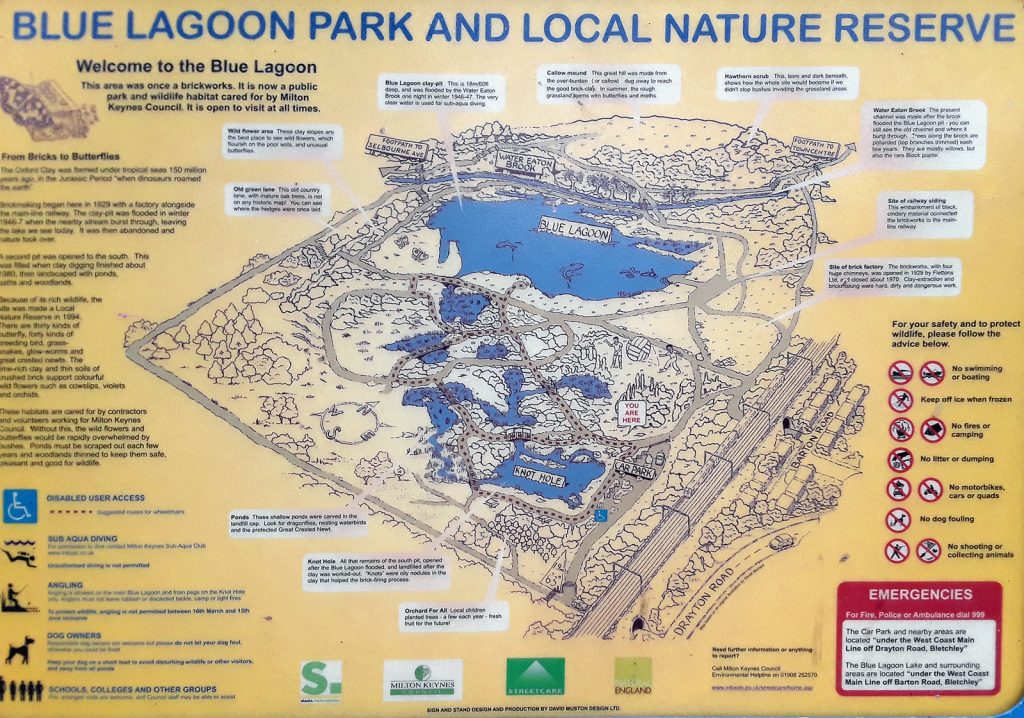
So why is swimming banned at so many lakes?
Many authorities, or owners or managers of lakes, do not understand outdoor swimming. They hear about risks and tragedies, and are influenced by insurers and risk-averse boards or locals. They are concerned about wildlife, other users, and possible impact.
In fact it can be done, with measures to mitigate risk such as informative signage and education. Bans achieve nothing, have to be policed, and do nothing to reduce risk and liability. Banning swimming doesn’t stop it, and can lead to it being done in a more rebellious way, in more hidden places where fewer people are around to help if there are problems or to influence behaviour. It is better to engage and educate, and to provide practical advice.
Swimmers’ organisations and groups, and especially local swimmers, can help: by engaging with swimmers and passing on good sensible safety information, liaising with landowners, helping with the impact of visitors such as litter and reporting problems, and with their knowledge and experience of swimming which landowners might not have.
The Outdoor Swimming Society has published this comprehensive guide to establishing inland beaches, with advice for landowners & managers on the law and practicalities – read about and download the OSS Guide to Inland Bathing Areas. And this article outlines Landowner liability and swimmers, based on RoSPA’s ‘Managing safety at inland waters guidance’ and the Visitor Safety Group‘s Guiding Principles, chapter 2 of detailed guidance, Managing Visitor Safety in the Countryside: Principles and Practice for landowners.
This by access campaigner Owen is also useful and most of it is relevant to clay lakes, Sixteen reasons why we need UK-wide swimming access in reservoirs. It explains the benefits of using these lakes for swimming – to those swimming, to society, the economy and the environment.
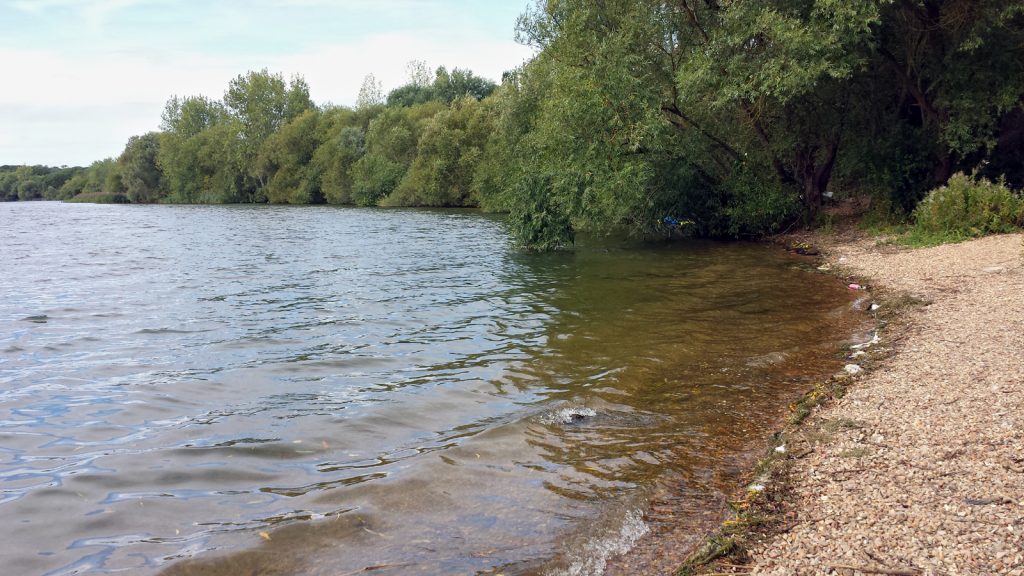
Sometimes there can be an impact of large numbers of visitors, such as masses of litter at the lake near Marston after the Bank Holiday weekend, and some people damage trees and have careless BBQs there or at the Blue Lagoon (whether swimming or not). Not all swim responsibly or have enough knowledge of how to be safe.
There can be real risks, but all can be mitigated by people following general advice and advice specific to the place. For example, at the lake near Marston there could be warnings to watch out for bricks, avoid some beaches, wear shoes and take care, don’t go out too far because of boats in part of the lake (and it is always best anywhere to stay near shore in case of getting cold). And there can be a steep drop from the beach into deep water, so non-swimmers and children would have to be supervised in or near the water.
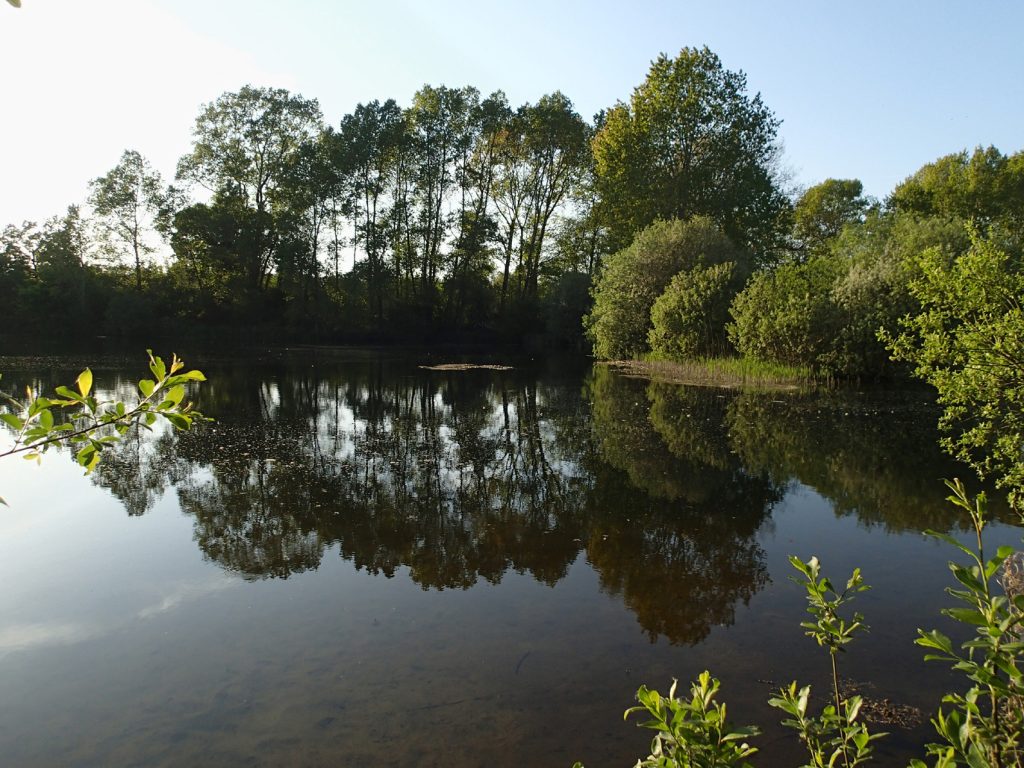
The same approach and advice can apply to reservoirs and old gravel pits. Local site-specific information can be given, and for a working reservoir this would include where to avoid structures, inlets and outlets.
Other Users
Boats – avoid area
Anglers – share lake by being in different areas or at different times
Wildlife – can cope with swimmers, low impact, should avoid sensitive areas and show respect to nature
Risks and other issues, and how to mitigate them (lakes)
Lakes can be prone to blue-green algae in hot weather, which can usually be seen, or warnings given.
| Risk | Mitigation |
| Deep | Keep near shore, supervise non swimmers and children, check if steep slope/drop, no inflatables, as might be washed out |
| Cold | Keep near shore, not in too long, warm clothes before and after, acclimatise, don’t jump in |
| Entry and exit points | check if steep slope/drop, if so supervise non swimmers and children, be sure you can get out, wear shoes and take care, find beaches less covered in bricks or debris, be sure you know where you can get out, especially if cold |
| Old bricks, litter, possibly sharp objects | wear shoes and take care, find beaches less covered in bricks or debris |
| Steep slope | check if steep slope/drop, if so supervise non swimmers and children, be sure you know where you can get out, especially if cold |
| Weeds | Keep out of weedy areas, or just gently float out if you become tangled. Try not to panic or thrash about. Don’t dive into weeds |
| Wildlife | Respect, avoid disturbing, avoid sensitive areas |
| Angling | Avoid |
| Boating/other activities | Avoid |
| Clean water | Look out for blue green algae and best not to go in, wash hands before eating, cover cuts.
Clay lakes are generally very clean |
| Antisocial and irresponsible behaviour | Educate to appreciate and care for environment, to behave responsibly |
| Litter | Don’t leave, pick up if you can do so safely |
| BBQs | Only if no fire risk, put out thoroughly and take away the litter |
| Unsafe behaviour | Educate on safety around and in water, provide advice and if appropriate lifebuoys (see RoSPA guidance) |
| Rules, bans | Access by public access areas/footpaths. Many campaigners say that if people do or have swum at an area this helps build the case for landowner/authority to recognise this. If they swim in an unsafe way then clearly education is needed. Banning swimming doesn’t work, as people will find less safe areas, opportunity lost to educate.
Organised swim venues have a role, but we also need free swimming, without barriers. |
Read article on safety on this website, and see more on the Links page.
Read about Landowner liability and swimmers and read about and download the OSS Guide to Inland Bathing Areas.
